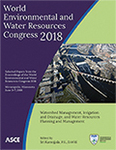World Environmental and Water Resources Congress 2018
A New Approach for Generating Flow Directions in Urban Watersheds
Publication: World Environmental and Water Resources Congress 2018: Watershed Management, Irrigation and Drainage, and Water Resources Planning and Management
ABSTRACT
Flow directions are important because they may be used to derive flow paths. These parameters are requisite in terrain-based flood mapping methods. Prior algorithms of flow direction generation are based in digital elevation models alone. Implicit in these methods is the assumption that elevation is the sole determinant in flow directions; however, such assumption may not be valid in complex landscapes such as in urban areas, where flow directions may be better described by the two-dimensional shallow water equations. A new approach for generating flow directions is therefore described. In the proposed approach, flow directions were derived using a hyper-resolution, hydrodynamic flood simulation instead of digital elevation models alone. With a city block in Austin, Texas, as a test case, results were compared to the widely used D∞ algorithm. It was concluded that elevation difference still greatly affects flow paths; nevertheless, flow is still a complex phenomenon in an urban landscape. The result therefore supports continued application of terrain-based models in rural areas but suggests that the use of hydrodynamic models is a more robust procedure in generating flow directions and flow paths and therefore deserves consideration for future research.
Get full access to this chapter
View all available purchase options and get full access to this chapter.
7. REFERENCES
Bakuła, K., StĘpnik, M., and Kurczyński, Z. (2016). “Influence of Elevation Data Source on 2D Hydraulic Modelling.” Acta Geophys., 64(4), 1176–1192.
Bruni, G., Reinoso, R., van de Giesen, N. C., Clemens, F. H. L. R., and ten Veldhuis, J. A. E. (2015). “On the sensitivity of urban hydrodynamic modelling to rainfall spatial and temporal resolution.” Hydrol. Earth Syst. Sci., 19(2), 691.
Costa-Cabral, M. C., and Burges, S. J. (1994). “Digital elevation model networks (DEMON): A model of flow over hillslopes for computation of contributing and dispersal areas.” Water Resour. Res., 30(6), 1681–1692.
Erskine, R. H., Green, T. R., Ramirez, J. A., and MacDonald, L. H. (2006). “Comparison of grid-based algorithms for computing upslope contributing area.” Water Resour. Res., 42(9).
Fairfield, J., and Leymarie, P. (1991). “Drainage networks from grid digital elevation models.” Water Resour. Res., 27(5), 709–717.
Guinot, V. (2012). “Multiple porosity shallow water models for macroscopic modelling of urban floods.” Adv. Water Resour., 37, 40–72.
Hodges, B. R. (2014). “A new approach to the local time stepping problem for scalar transport.” Ocean Model., 77, 1–19.
Hodges, B. R., and Rueda, F. J. (2008). “Semi-implicit two-level predictor–corrector methods for non-linearly coupled, hydrostatic, barotropic/baroclinic flows.” Int. J. Comput. Fluid Dyn., 22(9), 593–607.
Huang, G. H., and Chang, N. B. (2003). “The perspectives of environmental informatics and systems analysis.” J. Environ. Inform., 1(1), 1–7.
Jenson, S. K., and Domingue, J. O. (1988). “Extracting topographic structure from digital elevation data for geographic information system analysis. Photogramm. Eng. Rem. S., 54(11), 1593–1600.
Kim, B., Sanders, B. F., Famiglietti, J. S., and Guinot, V. (2015). “Urban flood modeling with porous shallow-water equations: A case study of model errors in the presence of anisotropic porosity.” J. Hydrol., 523, 680–692
Maidment, D. R. (2002). Arc Hydro: GIS for water resources (Vol. 1). ESRI, Inc.
O’Callaghan, J. F., and Mark, D. M. (1984). “The extraction of drainage networks from digital elevation data.” Comput. Gr. Image Process., 28(3), 323–344.
Quinn, P. F. B. J., Beven, K., Chevallier, P., and Planchon, O. (1991). “The prediction of hillslope flow paths for distributed hydrological modelling using digital terrain models.” Hydrol. Process., 5(1), 59–79.
Rueda, F. J., Sanmiguel-Rojas, E., and Hodges, B. R. (2007). “Baroclinic stability for a family of two-level, semi-implicit numerical methods for the 3D shallow water equations.” Int. J. Numer. Methods Fluids, 54(3), 237–268.
Seibert, J., and McGlynn, B. L. (2007). “A new triangular multiple flow direction algorithm for computing upslope areas from gridded digital elevation models.” Water Resour. Res., 43(4).
Soares-Frazão, S., Lhomme, J., Guinot, V., and Zech, Y. (2008). “Two-dimensional shallow-water model with porosity for urban flood modelling.” J. Hydraul. Res., 46(1), 45–64.
Tarboton, D. G. (1997). “A new method for the determination of flow directions and upslope areas in grid digital elevation models.” Water Resour. Res., 33(2), 309–319.
Tarboton, D. G. (2005). “Terrain analysis using digital elevation models (TauDEM).” Utah State University, Logan.
Wadzuk, B. M., & Hodges, B. R. (2004). “Hydrostatic and non-hydrostatic internal wave models.” Center for Research in Water Resources, University of Texas at Austin.
Information & Authors
Information
Published In
World Environmental and Water Resources Congress 2018: Watershed Management, Irrigation and Drainage, and Water Resources Planning and Management
Pages: 448 - 458
Editor: Sri Kamojjala, Las Vegas Valley Water District
ISBN (Online): 978-0-7844-8140-0
Copyright
© 2018 American Society of Civil Engineers.
History
Published online: May 31, 2018
Authors
Metrics & Citations
Metrics
Citations
Download citation
If you have the appropriate software installed, you can download article citation data to the citation manager of your choice. Simply select your manager software from the list below and click Download.
